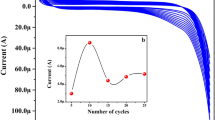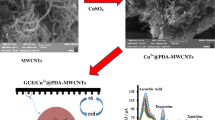Abstract
Fabricating a composite capable of detecting multiple analytes is important for advancing rapid medical diagnosis technology to assist in treating illnesses. A dendrimer-encapsulated Pt nanoparticle carbon nanotube (Pt–DEN–PANI–CNT) composite-based electrochemical biosensor was fabricated for the detection of hydrogen peroxide (H2O2), ascorbic acid (AA), and acetaminophen (AP), important for monitoring AP overdose-induced poisoning. Polyaniline (PANI) was used to coat single-walled carbon nanotubes (CNTs), which were then decorated with Pt-encapsulated, fourth-generation NH2-terminated poly(amidoamine) (G4-PAMAM) dendrimers. X-ray photoelectron (XPS) and attenuated total reflectance infrared (ATR-IR) spectroscopies, and transmission electron microscopy (TEM) were used to characterize the nanocomposite material. Electrocatalytic activity of the Pt–DEN–PANI–CNT composite was studied using cyclic voltammetry (CV) and chronoamperometric (CA) techniques. Point-of-zero charge (PZC) measurements showed that the isoelectric point of the composite was at pH 6.8, an important parameter to consider in explaining differences in selectivity of the composite to these various analytes. Measured chronoamperometric signals for AA, H2O2, and AP were found in the concentration ranges of 10 μM–10 mM, 50 μM–8 mM, and 20 μM–1 mM, respectively. Within this series of analytes, the Pt–DEN–PANI–CNT composite can selectively detect both H2O2 and AP, separately, in the presence of the other analytes with rapid current response (<5 s) and good reproducibility.
Graphical Abstract










Similar content being viewed by others
References
Sage AT, Besant JD, Lam B, Sargent EH, Kelley SO (2014) Ultrasensitive electrochemical biomolecular detection using nanostructured microelectrodes. Acc Chem Res 47:2417–2425
Lippert AR, Van de Bettner GC, Chang CJ (2011) Boronate oxidation as a bioorthogonal reaction approach for studying the chemistry of hydrogen peroxide in living systems. Acc Chem Res 44:793–804
Bourn IM, Bourcier DR (1988) Influence of ascorbic acid esters on acetaminophen-induced hepatotoxicity in mice. Toxicol Lett 44:39–46
Prescott LF (1980) Hepatotoxicity of mild analgesics. Br J Clin Pharmacol 10(Suppl 2):373S–379S
Hinson JA, Roberts DW, James LP (2010) Mechanisms of acetaminophen-induced liver necrosis. Handb Exp Pharmacol 196:369–405
Puntarulo S, Cederbaum AI (1996) Role of cytochrome P-450 in the stimulation of microsomal production of reactive oxygen species by ferritin. Biochim Biophys Acta 1289:238–246
James LP, Mayeux PR, Hinson JA (2003) Acetaminophen-induced hepatotoxicity. Drug Metab Dispos 31:1499–1506
Adikwu E, Deo O (2013) Hepatoprotective effect of vitamin C (ascorbic acid). Pharmacol Pharm 4:84–92
Yu JM, Jeong YN, Ahmed MS, Kim SK, Choi HC, Jeon S (2011) Reductive determination of hydrogen peroxide with MWCNTs-Pd nanoparticles on a modified glassy carbon electrode. Biosens Bioelectron 26:2287–2291
Shahrokhian S, Saberi RS (2011) Voltammetric determination of acetaminophen in the presence of codeine and ascorbic acid at layer-by-layer MWCNT/hydroquinone sulfonic acid-overoxidized polypyrrole modified glassy carbon electrode. Int J Electrochem 2011:1–10
Yan J, Liu S, Zhang Z, He G, Zhou P, Liang H, Tian L, Zhou X, Jiang H (2013) Simultaneous electrochemical detection of ascorbic acid, dopamine and uric acid based on graphene anchored with Pd-Pt nanoparticles. Colloids Surf B 111:392–397
Zhu Y, Zhu H, Yang X, Xu L, Li C (2007) Sensitive biosensors based on (dendrimer encapsulated Pt nanoparticles)/enzyme multilayers. Electroanalysis 19:698–703
Zhu H, Zhu Y, Yang X, Li C (2006) Multiwalled carbon nanotubes incorporated with dendrimer encapsulated with Pt nanoparticles: and attractive material for sensitive biosensors. Chem Lett 35:326–327
Tang L, Zhu Y, Yang X, Li C (2007) An enhanced biosensor for glutamate based on self-assembled carbon nanotubes and dendrimer-encapsulated platinum nanobiocomposites-doped polypyrrole film. Anal Chim Acta 597:145–150
Siriviriyanun A, Imae T (2012) Advantages of immobilization of Pt nanoparticles protected by dendrimers on multiwalled carbon nanotubes. Phys Chem Chem Phys 14:10622–10630
Siriviriyanun A, Imae T (2013) Advantages of electrodes with dendrimer-protected platinum nanoparticles and carbon nanotubes for electrochemical methanol oxidation. Phys Chem Chem Phys 15:4921–4929
Siriviriyanun A, Imae T, Nagatani N (2013) Electrochemical biosensors for biocontaminant detection consisting of carbon nanotubes, platinum nanoparticles, dendrimers, and enzymes. Anal Biochem 443:169–171
Gasporotto LHS, Castelhano ALB, Silva ACA, Dantas NO, Oliveira ON, Siqueira JR (2014) Dendrimer-carbon nanotube layer-by-layer film as an efficient host matrix for electrogeneration of PtCo electrocatalysts. Phys Chem Chem Phys 16:2384–2389
Wayu MB, Spidle RT, Devkota T, Deb AK, Delong RK, Ghosh KC, Wanekaya AK, Chusuei CC (2013) Morphology of hydrothermally synthesized ZnO nanoparticles tethered to carbon nanotubes affects electrocatalytic activity for H2O2 detection. Electrochim Acta 97:99–104
Wayu MB, King JE, Johnson JA, Chusuei CC (2015) A zinc oxide carbon nanotubed based sensor for in situ monitoring of hydrogen peroxide in swimming pools. Electroanalysis 27:2552–2558
McPhail MR, Sells JA, He Z, Chusuei CC (2009) Charging nanowalls: adjusting the carbon nanotube isoelectric point via surface chemical functionalization. J Phys Chem C 113:14102–14109
Hull RV, Li L, Xing Y, Chusuei CC (2006) Pt nanoparticle binding on functionalized multiwalled carbon nanotubes. Chem Mater 18:1780-1788
Weiler M, Sattel S, Jung K, Ehrhardt H, Veerasamy V, Robertson J (1994) Highly tetrahedral, diamond-like amorphous hydrogenated carbon prepared from a plasma beam source. Appl Phys Lett 64:2797–2799
Ramanathan F, Fisher FT, Ruoff RS, Brinson LC (2005) Amino-functionalized carbon nanotubes for binding to polymers and biological systems. Chem Mater 17:1290-1295
Kundu S (2008) Thermal stability and reducibility of oxygen-containing functional groups on multiwalled carbon nanotube surfaces: a quantitative high-resolution XPS and TPD/TPR study. J Phys Chem C 112:16869–16878
López GP, Castner DG, Ratner BD (1991) XPS O 1s binding energies for polymers containing hydroxyl, ether, ketone and ester groups. Surf Interface Anal 17:267–272
McCafferty E, Wightman JP (1998) Determination of the concentration of surface hydroxyl groups on metal oxide films by a quantitative XPS method. Surf Interface Anal 26:549–564
Lin Y, Chen X, Lin Y, Zhou Q, Tang D (2015) Non-enzymatic sensing of hydrogen peroxide using a glassy carbon electrode modified with a nanocomposite made from carbon nanotubes and molybdenum disulfide. Microchim Acta 182:1803–1809
Brown GE, Henrich VE, Casey WH, Clark DL, Eggleston C, Felmy A, Goodman DW, Grätzel M, Maciel G, McCarthy MI, Nealson KH, Sverjensky DA, Toney MF, Zachara JM (1999) Metal oxide surfaces and their interactions with aqueous solutions and microbial organisms. Chem Rev 99:77–174
Acknowledgments
We gratefully acknowledge support of this work by the Faculty Creative Activity Committee (FRCAC) of Middle Tennessee State University. We also thank Ms. Joyce Miller for assistance in obtaining the TEM data.
Author information
Authors and Affiliations
Corresponding author
Electronic supplementary material
Below is the link to the electronic supplementary material.
Rights and permissions
About this article
Cite this article
Deb, A.K., Das, S.C., Saha, A. et al. Ascorbic acid, acetaminophen, and hydrogen peroxide detection using a dendrimer-encapsulated Pt nanoparticle carbon nanotube composite. J Appl Electrochem 46, 289–298 (2016). https://doi.org/10.1007/s10800-016-0922-8
Received:
Accepted:
Published:
Issue Date:
DOI: https://doi.org/10.1007/s10800-016-0922-8




